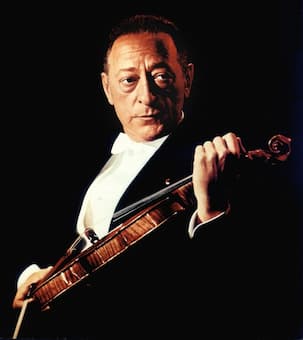
Jascha Heifetz, 1969
After the 19-year-old Jascha Heifetz played his London debut, Georg Bernard Shaw wrote to him, “If you provoke a jealous God by playing with such superhuman perfection, you will die young. I earnestly advise you to play something badly every night before going to bed, instead of saying your prayers. No mortal should presume to play so faultlessly.” Heifetz had previously given his debut with André Benoist at the piano at Carnegie Hall in New York, on 27 October 1917. He was hailed as a “transcendentally great violinist,” and a critic wrote, “a tall Russian boy with a mop of curly hair walked out on the stage of Carnegie Hall and made the ideal a reality.”

The young Heifetz
Heifetz had plenty of technique to spare, but “better than this is the exquisite finish, elasticity and resource of his bowing, which gives him a supreme command of all the tonal nuances essential to style and interpretation.” Another critic added, “Heifetz’s breadth, poise, and perfect regard for the turn of a phrase constantly left his hearers spellbound. Nothing that he undertook was without a finish so complete, so carefully considered and worked out, that its betterment did not seem possible…For the moment it is sufficient to say that he is supreme; a master, though only [sixteen], whose equal this generation will probably never meet again.”
Heifetz Plays Tchaikovsky
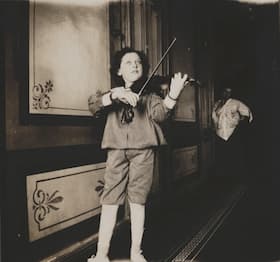
Jascha Heifetz at home in Vilnius
Some of the greatest violinists had come to Carnegie Hall to hear Heifetz, including Fritz Kreisler, Maud Powell, Franz Kneisel, and David Mannes. Also present was Mischa Elman, an extraordinary violinist from the studio of Leopold Auer.
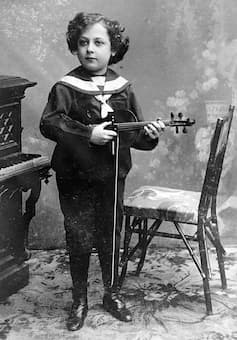
Jascha Heifetz as a young boy
Elman had been performing in the United States since 1908, and seated next to him at the Heifetz recital was the pianist Leopold Godowsky. According to a frequently retold anecdote, “As the first half of the recital progressed, Elman leaned over to Godowsky and whispered: “It’s awfully hot in here.” Without missing a beat, Godowsky replied: “Not for pianists.” Heifetz had also been an Auer student, and he credited him with teaching “the true art of bowing, which involved absolute relaxation of the bow arm and wrist.” In 1918, Heifetz said, “Auer is a wonderful and an incomparable teacher; I do not believe there is one in the world who can possibly approach him. Do not ask me just how he does it, for I would not know how to tell you… Half an hour with Auer is always to me a great emotional and intellectual stimulus.”
Heifetz Plays Paganini Caprice No. 24
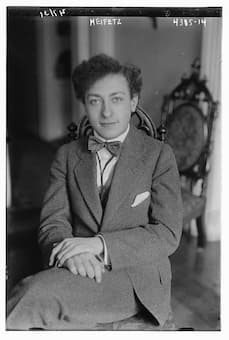
Jascha Heifetz in 1917
Jascha Heifetz was born into a Russian-Jewish family in Vilnius, Lithuania, on 2 February 1901. His father was a local violin teacher and served as the concertmaster of the Vilnius Theatre Orchestra. He quickly understood that his son had special musical abilities, and he bought Jascha a small violin at the age of two. He initially taught him bowing and simple fingering, and by the age of five Jascha started lessons at the local music school with Ilya Malkin. He first appeared in a student recital in December 1906, and at the age of eight made his formal public debut in Kaunas playing the Mendelssohn E-minor Violin Concerto. Heifetz entered the St. Petersburg Conservatory in 1910, initially studying with I.R. Nalbandian. Heifetz had already played a number of concerts and even made a recording before entering the class of Leopold Auer in 1911. By then, scholars report, “his public performances were already creating a sensation. One outdoor concert in Odessa in the summer of 1911 reportedly drew as many as 8,000 people. The young Nathan Milstein, who was in the audience, recalled that the police surrounded the boy when he finished playing to protect him from the surging crowd.”
Felix Mendelssohn: Violin Concerto in E Minor, Op. 64, MWV O14 (Jascha Heifetz, violin; Boston Symphony Orchestra; Charles Munch, cond.)
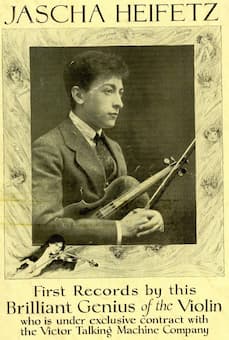
Poster of the first recording of Jascha Heifetz, 1917
© Library of Congress
Heifetz took Europe by storm, and he was announced “as a little boy who is already a great violinist, a genius.” During his first appearance in Berlin in 1912, Heifetz played at a private press matinee at the home of Arthur Abell, the Berlin critic for the American magazine Musical Courier. Some of the leading violinists attended, including Fritz Kreisler. Heifetz played the Mendelssohn concerto with Marcel van Gool at the piano, and Kreisler “reportedly turned to his fellow violinists and said, ‘We might as well take our fiddles and smash them across our knees.’” Heifetz also performed in Warsaw and Prague in 1912, and he toured Germany, Austria and Hungary in 1914.
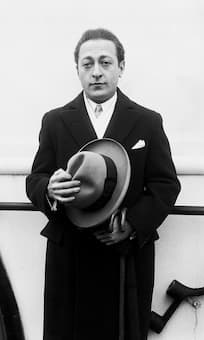 Heifetz was also looking to make his American debut in 1914. Unable to make that journey owing to the outbreak of World War I, the Heifetz family finally departed during the first rumblings of the Russian Revolution in 1917. They took the Trans-Siberian Railroad from St. Petersburg to Japan, before setting sail for the United States. “Crossing the Pacific Ocean with a stop in Hawaii, the family landed in San Francisco and subsequently travelled the length of the United States by train, finally arriving in New York at the end of August.” Heifetz may well be “regarded as the greatest violin virtuoso since Paganini, as he set all standards for 20th-century violin playing. Itzhak Perlman once famously wrote, “The goals he set still remain, and for violinists today it’s rather depressing that they may never really be attained again.”
Heifetz was also looking to make his American debut in 1914. Unable to make that journey owing to the outbreak of World War I, the Heifetz family finally departed during the first rumblings of the Russian Revolution in 1917. They took the Trans-Siberian Railroad from St. Petersburg to Japan, before setting sail for the United States. “Crossing the Pacific Ocean with a stop in Hawaii, the family landed in San Francisco and subsequently travelled the length of the United States by train, finally arriving in New York at the end of August.” Heifetz may well be “regarded as the greatest violin virtuoso since Paganini, as he set all standards for 20th-century violin playing. Itzhak Perlman once famously wrote, “The goals he set still remain, and for violinists today it’s rather depressing that they may never really be attained again.”
For more of the best in classical music, sign up to our E-Newsletter
Heifetz Plays Bach Partita No. 2
